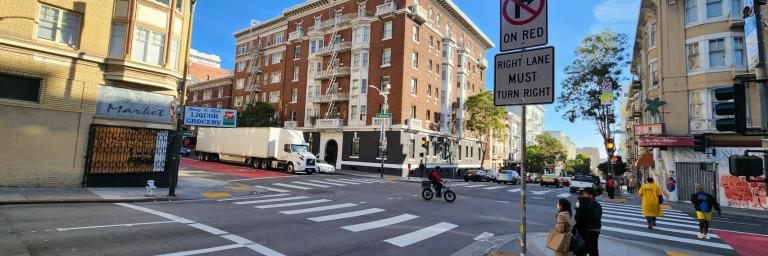What is a Quick-Build project?
Quick-build projects are adjustable and reversible traffic safety improvements that can be installed relatively quickly. Unlike major capital projects that may take years to plan, design, bid and construct, quick-build projects are buildable within months and are intended to be evaluated and reviewed within 24 months of construction.
-
Road diet (i.e., remove one or two travel lanes)
-
Paint, traffic delineators, and street signs
-
Parking and loading adjustments
-
Traffic signal timing
-
Transit boarding islands
Project Outreach
The initial phase of outreach was completed at the end of January. Within this phase, project staff along with community partners hosted community outreach events and connected with community members along Hyde Street and beyond to better understand mobility and safety needs. During Phase 2, staff will share design proposals for feedback to help inform the preferred design. Prior to implementation, this project will need to go through a City approval process, including a public hearing, and possibly Board approval.
Project Evaluation
All SFMTA quick-build projects are intended to be evaluated through our Safe Streets Evaluation Program within the initial 24 months of construction. The Safe Streets Evaluation Program will analyze the project before and after implementation to review outcomes and determine design effectiveness. Evaluations will inform near-term modifications and a longer-term design for this street.
- Completed
COVID-19 Pandemic
During the COVID-19 pandemic, safety challenges were further exacerbated in the neighborhood showing an increasing need for traffic safety improvements. To respond to these challenges, the SFMTA initiated the Tenderloin COVID Emergency Streets program in 2020 and 2021. This program was designed to expand walking space, enabling physical distancing by using temporary street closures to support small businesses & neighborhood services. This response work was implemented across the Tenderloin (i.e., Jones Street, Turk Street, Larkin Street, the 100 block of Golden Gate Avenue, and the 300 block of Ellis Street). These response efforts showed markable improvements for those walking and traveling by car. The SFMTA has taken additional actions along these corridors, using the quick-build program to re-affirm the City’s commitment to making the Tenderloin community safer for the most vulnerable road users
In addition to the Tenderloin COVID Emergency Streets program, SFMTA also completed neighborhood wide traffic safety improvements during the height of the pandemic. Building on past comprehensive neighborhood-wide efforts in the Tenderloin, including daylighting and signal retiming, the City reduced the neighborhood speed limit from 25 miles to 20 miles per hour and implemented “no turn on red” regulations. Studies show that lowering speeds greatly improves a pedestrian’s chance of survival in the event of a collision. The Tenderloin was the first neighborhood in San Francisco to have widespread speed reductions. Tenderloin No Turn on Red Evaluation Summary
